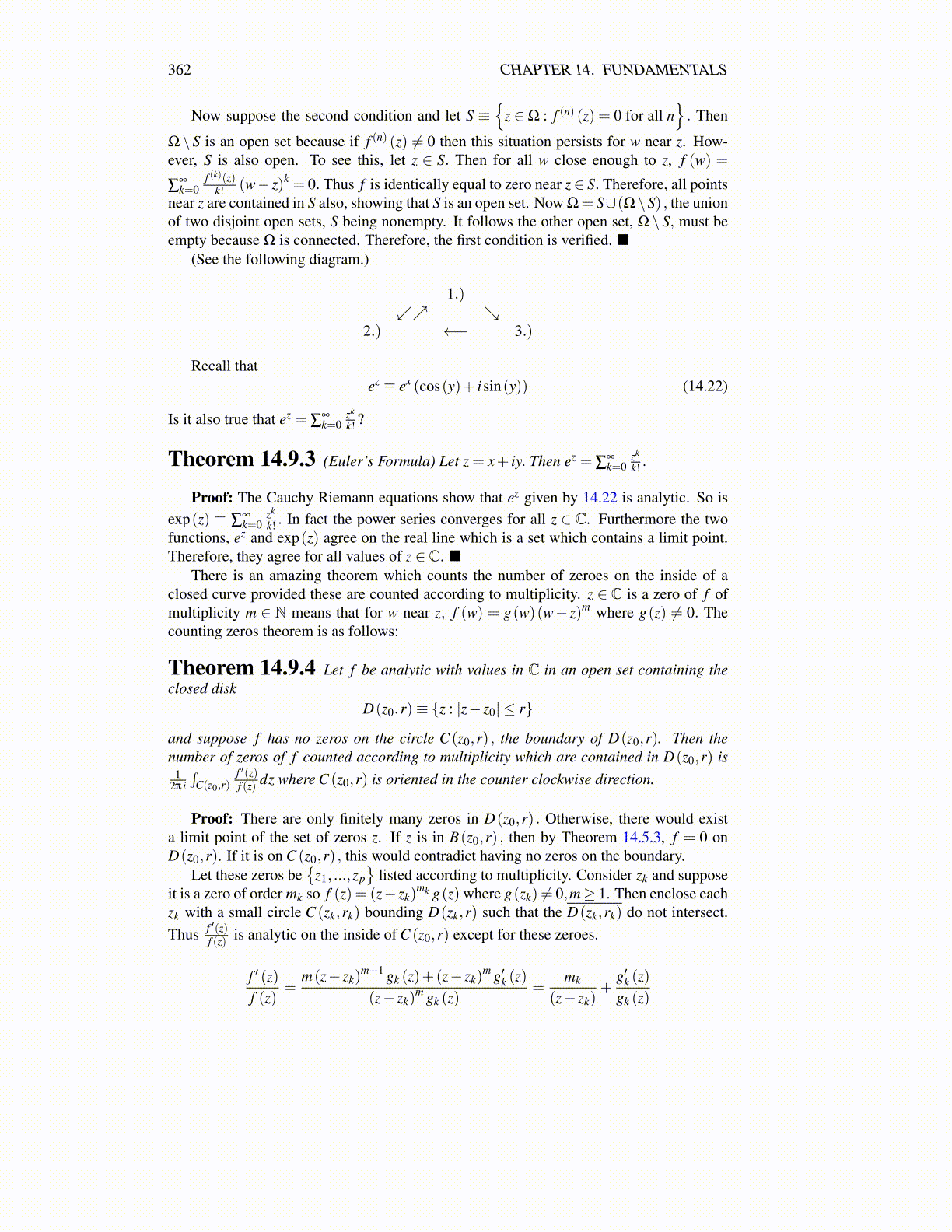
362 CHAPTER 14. FUNDAMENTALS
Now suppose the second condition and let S ≡{
z ∈Ω : f (n) (z) = 0 for all n}. Then
Ω \ S is an open set because if f (n) (z) ̸= 0 then this situation persists for w near z. How-ever, S is also open. To see this, let z ∈ S. Then for all w close enough to z, f (w) =
∑∞k=0
f (k)(z)k! (w− z)k = 0. Thus f is identically equal to zero near z∈ S. Therefore, all points
near z are contained in S also, showing that S is an open set. Now Ω= S∪(Ω\S) , the unionof two disjoint open sets, S being nonempty. It follows the other open set, Ω \ S, must beempty because Ω is connected. Therefore, the first condition is verified. ■
(See the following diagram.)
1.)↙↗ ↘
2.) ←− 3.)
Recall thatez ≡ ex (cos(y)+ isin(y)) (14.22)
Is it also true that ez = ∑∞k=0
zk
k! ?
Theorem 14.9.3 (Euler’s Formula) Let z = x+ iy. Then ez = ∑∞k=0
zk
k! .
Proof: The Cauchy Riemann equations show that ez given by 14.22 is analytic. So isexp(z) ≡ ∑
∞k=0
zk
k! . In fact the power series converges for all z ∈ C. Furthermore the twofunctions, ez and exp(z) agree on the real line which is a set which contains a limit point.Therefore, they agree for all values of z ∈ C. ■
There is an amazing theorem which counts the number of zeroes on the inside of aclosed curve provided these are counted according to multiplicity. z ∈ C is a zero of f ofmultiplicity m ∈ N means that for w near z, f (w) = g(w)(w− z)m where g(z) ̸= 0. Thecounting zeros theorem is as follows:
Theorem 14.9.4 Let f be analytic with values in C in an open set containing theclosed disk
D(z0,r)≡ {z : |z− z0| ≤ r}
and suppose f has no zeros on the circle C (z0,r) , the boundary of D(z0,r). Then thenumber of zeros of f counted according to multiplicity which are contained in D(z0,r) is
12πi∫
C(z0,r)f ′(z)f (z) dz where C (z0,r) is oriented in the counter clockwise direction.
Proof: There are only finitely many zeros in D(z0,r) . Otherwise, there would exista limit point of the set of zeros z. If z is in B(z0,r) , then by Theorem 14.5.3, f = 0 onD(z0,r). If it is on C (z0,r) , this would contradict having no zeros on the boundary.
Let these zeros be{
z1, ...,zp}
listed according to multiplicity. Consider zk and supposeit is a zero of order mk so f (z) = (z− zk)
mk g(z) where g(zk) ̸= 0,m≥ 1. Then enclose eachzk with a small circle C (zk,rk) bounding D(zk,r) such that the D(zk,rk) do not intersect.Thus f ′(z)
f (z) is analytic on the inside of C (z0,r) except for these zeroes.
f ′ (z)f (z)
=m(z− zk)
m−1 gk (z)+(z− zk)m g′k (z)
(z− zk)m gk (z)
=mk
(z− zk)+
g′k (z)gk (z)